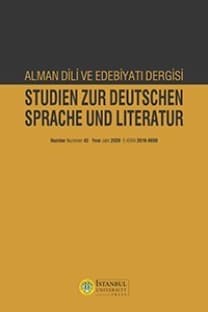Çoklu perspektiflilik, anakroni ve güvenilmezlik: Vantage Point ve Forestillinger örneğinde günümüz filminde sinoptik ve kaleidoskopik yöntemler
Bu makale günümüz filmlerinde çoklu perspektifliliği ve güvenilmez anlatıcıyı ele almaktadır. İki örnek yapımın analizi (Kuzey Amerikan filmi Vantage Point ve Danimarka televizyon dizisi Forestillinger) bir yandan güvenilirlik izleniminin çeşitli perspektiflerin yan yana konulmasıyla oluşturulduğunu gösteriyor: Bu filmlerin medyasal iletim biçimi – güvenlik kameralarıyla izlenen binaların kontrol odasına benzer biçimde – nesnelliği, her şeyi görebilmeyi ve ayrıntıya ilişkin bilgiyi vaat ediyor gibi. Fakat diğer yandan filmsel araçların kullanılması bunların olabilirliğini daha en başından itibaren sorgulamaktadır, çünkü ancak kameranın ve montajın kullanımıyla insanın nesnel biçimde göremeyecek durumda olduğu, her zaman belli bir perspektifle baktığı, her şeyi görmenin duyusal bakımdan mümkün olmadığı ve üçüncüsü ayrıntıya ilişkin bilginin kameranın kullanılma biçimine bağlı olduğu anlaşılıyor. Buradaki ana sav, medyanın geleneksel amacının (nesnellik, her şeyi görmek, ayrıntıya ilişkin bilgi) ve buradaki içe bakma vaadinin malzemenin medyadaki biçimsel işlenişiyle boşa çıkartıldığıdır. Vantage Point ve Forestillinger yapımları bu bakımdan ortak bir özelliğe sahip: ikisi de olay sekanslarını çeşitli bakış açılarından tekrarlıyor. Fakat önemli bir noktada da birbirinden ayrılıyorlar: Vantage Point ana akım film olarak önceden belirlenmiş bir yoruma doğru parçaların arka arkaya gösterilmesiyle ilerlerken ve bu nedenle sinoptik bakımdan güvenilir bir anlatımı belli sekansların güvenilmezliğine rağmen amaçlarken, bu yorum çalışması Forestillinger‘de tümüyle alımlayıcıya bırakılmaktadır. Gerçekliğin buradaki anlatımı, algılamanın güvenilmezliğinin ve bundan kaynaklanan kaleidoskopik gösterim biçiminin sergilenmesinden ibarettir.
Multiperspektivität, Achronie und (Un)Zuverlässigkeit: Synoptische und kaleidoskopische Verfahren im Gegenwartsfilm am Beispiel von Vantage Point und Forestillinger
The article addresses the relationship of multiperspectivity and unreliable narration in contemporary film. The analysis of two examples (the North American film Vantage Point and the Danish TV-serial Forestillinger) shows how, on the one hand, reliability is established through the composition of various perspectives: The medial transmission of these films resembles the central control room of a closed-circuit monitored building, and seems to promise objectivity, overview and insight into details. The use of cinematographic techniques, on the other hand, calls these promises into question from the outset, because the camera work and the editing make clear that, first, we are not capable of seeing objectively but only perspectively; second, an overview is sensorily impossible; and third, the knowledge of details is always a question of zoom, light and focus and therefore only granted by the technical camera work. The main thesis is that the formal layout of the material in the medium plays through the traditional demand made of the medium (objectivity, overview, insight into details), and its intrinsic promise to fulfill this task, ad absurdum. Vantage Point and Forestillinger have one thing in common: they repeat sequences of the plot from different points of view. But they also differ in a decisive aspect: Whereas Vantage Point as a mainstream film steers towards a preset interpretation in the synopsis of the episodes in the end, and therefore aims at a synoptically reliable narration despite the unreliability of partial sequences, Forestillinger instead leaves this interpretive work up to the recipient. As a result, the narration of reality is reliable insofar as exactly the unreliability of perception is exhibited, which results in the kaleidoscopic mode of representation.
Keywords:
Multiperspectivity, Unreliability, Objectivity, Seriality Repetition,
___
- Booth, Wayne C. (1961): Rhetoric of Fiction, Chicago.
- Başlangıç: 1954
- Yayıncı: İstanbul Üniversitesi
